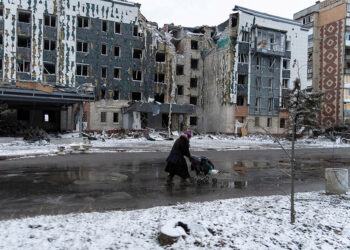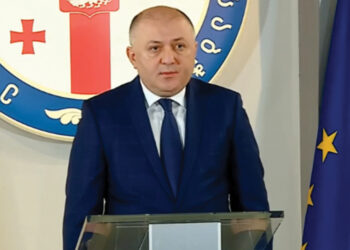If I was a Russian pilot with 100 hours training in an aircraft, I am going to be shit scared of getting airborne and wondering whether there’s an F16 up there – Greg Bagwell, retired Air Marshall and combat pilot, the UK’s Air Commander for four years and current President of the Air and Space Power Association, told RFE/RL’s Georgian Service. We sat down with him to talk more about the war and the weapons and tactics being chosen in fighting it.
Not much has gone according to plan for the Russians in this war. What are the reasons behind Russia’s failure to establish uncontested air supremacy?
You could argue they never thought they needed it, that they thought this would be over quickly, that they would destabilize the country with very little fuss. That was the first thing that went wrong. Based on what they say they can do, you would think they’d be more than a match for Ukraine, and potentially more than a match for the West. But, actually, that’s never been borne out. On the surface, they might have the capabilities, the numbers, but if you don’t have the logistics support, the networks, the data management, the supply chain, the armament interface, the sensors, and perhaps even more importantly, the level of training, then your very expensive, very capable machine isn’t able to perform at the highest level of its function. What we’ve seen, particularly from the Russian Air Force, is that they don’t have the skills to get the full potential from their platforms, because their training is rather regimental, formulaic; because they have set processes and procedures. The West doesn’t fight like that. We’re far more fluid. We have the networks and the sensors, and like to fight a far more fluid battle. Russia’s not good at that. It’s good at military mass and pushing and overwhelming, as proven in Syria and elsewhere, but in Ukraine they met someone that is thinking far more cleverly than they are, and they’re not able to catch it. So I think that is a key part to why we haven’t seen Russian airpower. They’re also probably quite fearful of Ukraine, and being shot down in Ukraine, losing one of their high-end, rather expensive and rather modern pieces of equipment and compromising the intelligence. That’s why they’re relying on either indiscriminate attacks or long range missiles that only have a certain effect against fixed targets, which more often than not tend to be civilian in nature.

What’s the reasoning behind the West not sending their F16s to Ukraine?
I say we should, but there is a perception, falsely, in my view, that aircraft cross some red line as to what is acceptable to Russia in order to support Ukraine. And, of course, Russia would want that impression to go on, because the last thing they need a western aircraft troubling them over the skies of Ukraine. I think the view is that aircraft can be offensive in nature and clearly strike a lot deeper and can go into Russian territory. There’s the assumption that Putin will see that as a step too far and will react potentially very disproportionately. And there is a concern that it might drag other nations, NATO, into the conflict. Everyone’s trying to avoid escalation. And that’s the question here: Are we, in gifting aircraft, going to push Russia into a very different response either against Ukraine or potentially against supporting nations? But I don’t think so. As much as Russia doesn’t want to see a modern aircraft on the front line, I don’t think it’s going to push them into doing something irrational.
I think if jets are used in a limited role, particularly for the defense of Ukraine, it can’t be seen as escalatory: It’s merely giving the tools to a nation for it to defend its sovereign borders, in accordance with international law. There’s nothing there that you can pick holes in. Some thought tanks were a step too far, but we’ve busted through that glass ceiling.
With the tanks, the West dragged their feet, then caved. Will we see a repeat with the jets?
We were talking very early on last year about potentially gifting MIG 29s from former Eastern European Soviet bloc nations to Ukraine. That fell foul because Poland didn’t want to gift them directly and asked America to effectively be the third party agent, but America didn’t want to be seen as the agent. There are diplomatic issues in the background here about what can and can’t be gifted. There are multiple nations that can donate F16s. It doesn’t have to be America, America just has to give permission. F16s aren’t the only answer. But because of what it can do, because of how many there are, because of the fact that we can have multiple donors, so no one or two nations would necessarily be singled out, it offers a really strong case for why that aircraft is potentially the right answer. It may be in the calculation of the US President that as long as he’s not the person that gifts the aircraft directly, then it might be acceptable.
Unfortunately, we’re seeing a diplomatic political dance here to get to a place where everyone can go. It frustrates me because it takes time to learn about a new aircraft and all the systems and situations you’ll need. Ukraine will do it far faster than normal, yes, but the tanks will be going in soon, and as it stands, they’ll be going in without air support. We’re trying to help Ukraine fight this war in phases, without giving them all the tools they need.
Giving Ukraine just enough not to lose and not enough to win?
Yes, that’s the danger here. Nobody but Russia wants to see Russia win. Their losing might be enough to put all the problems onto Putin, for a regime change, for the collapse of that particular organization. But that would be paid for in the lives of Ukrainians. That’s a moral step that I struggle to accept. If we were to give them the tools now, they could get to that position far more quickly. There is a danger here that people are making a calculation that by drip feeding just enough, they won’t lose, but they won’t necessarily win, and that gives time for other things to take place and maybe a resolution will be made. That’s a very strange way to fight a war against an aggressor who’s broken every international law. I really struggle with that position.
We shouldn’t just see this as how to win the war that’s coming this spring; we need to think about how we can win peace too. Having enough aircraft with the longevity to go for the next 10 – 15 years is just as important a consideration. And I think Ukraine would be wrong to think too short-term: If we’re going to do this, let’s do it properly: Let’s make sure that they’ve got a solution for the next decade too.
What are the training / logistical hindrances brought up as an argument against gifting the F16s? How long would it take to train Ukrainian troops to learn?
If you were a combat pilot already, had already flown the MiG 29 in combat, and let’s be honest, Ukraine right now has some of the most experienced combat pilots in the world by dint of the last year, and I hope many of them are still going strong, then somebody of that caliber would be able to transfer on to a new aircraft within about six to eight weeks. Now that’s quite aggressive, but doable with virtual reality simulation, by not having to learn every trick in the book and every system – they could do the basics.
Essentially, all airplanes fly the same. Up, down, left, right; the same throttles; go forward, go faster, come back, go slow. Using the radar, employing the weapons, locking up targets requires a little bit of finesse, but you won’t be surprised to know that modern Western aircraft have got that down to a relatively fine art. So it is learnable in a relatively quick time.
Slightly more difficult is the maintainers learning how to keep the airplane serviceable, make it work, get the weapons on it- that takes some time. But, again, it’s not rocket science. With virtual reality, a maintainer could be sat there with a camera on his head with somebody back wherever talking him through the processes. There are lots of different ways that we could make this work. And modern aircraft these days, it’s not about lifting the hood and getting your wrench out and mucking about and hitting it with hammers. It’s mostly box in, box out.
My personal opinion is that this has been used as an excuse as to why they can’t be sent because it’s a rather convenient excuse. They’ve been fighting now for a year; they could have done the full course twice over. So let’s stop using the reason that there’s not enough time and get to the real truth, which is when are you going to get the courage to do what’s right, because the training will happen. Ukraine will make it work – if they can learn how to operate three different main battle tanks in a few months, they can learn how to operate an F16.
Just how much of a game-changer would Western-manufactured fighter jets be? Can Ukraine get by without them?
Ukraine has clearly been an incredible nation in so many different ways – not only the resilience of the entire nation to just keep going, but to be able to effectively dull a country of so much greater in size, aggression, military might, etc. and hold them at bay. I mean, it’s unbelievable. In many ways, Ukraine is its own worst enemy, because we don’t see how desperate the situation is when everyone thinks Ukraine is achieving great victories. There are times when they have, but actually, they are still under extreme pressure. Half the problem is trying not to oversell how well Ukraine has done, even though they have done extremely well. They’ve clearly been able to match the Russian Air Force to a large extent, on the terms that they can, though some of these longer range missiles are harder to attack. And yes, some of that is done through Surface to Air Systems rather than air to air systems. I’d like to believe Ukraine will find a way no matter what. So it isn’t a deal breaker, but I think the risks are too high of them losing if we don’t help them to the maximum extent.
Tell us more about the F16.
The F16 has good radar, it can fly well above the majority of the Russian sound systems in the area, apart from the very, very specialized ones. It has a weapon system tied to that radar that can engage the vast majority of Russian aircraft long before they can attack it. The F16 doesn’t have the quite the same stealth characteristics of something like an F35 or F22. But I’ve fought against the F16. I’ve had the odd trip in one but I’ve also fought against it. It’s tiny, hard to see on radar, even harder to see in the air with the naked eye. The F16 is not called a viper for nothing: It’s a vicious, nasty, dangerous little airplane. And if I was a Russian pilot with 100 hours training in an aircraft, I’d be nervous about whether my weapons would really work, because I’ve never been allowed to use them in training or wartime; I’d be shit scared of getting airborne and wondering whether there’s an F16 up there.
If we can take Russian airpower and limit its influence on the battlefield and over Ukraine in general, that gives Ukraine breathing space, which is then going to allow the Combined Arms effect of the artillery, the HIMARS, the tanks and everything else, to operate without any concern about what’s above. That will be hugely powerful.
If Putin needs to think long-term about what he’s going to end up showing his few allies: That the Russian equipment is no good, that Western airpower and ground power is ultimately way better than the Russian kit. It’s going to send powerful messages to his allies about what they should be buying or what they can trust. And it’s going to send ripples through an army and an air force that suddenly no longer has confidence in its equipment.
How detrimental could it be for Ukraine if the West refuses to supply those jets?
If the West chooses to limit its help to tanks, it sends a very poor message to Ukraine. It says, “we’ll help you as much as we can, but we’re not going to give you everything.” And that will not help Ukraine’s morale or their belief that we’ve got their back, and we should have their back. I think it will also send a strong message to Russia that there is actually a red line. And if Putin pushes hard enough he can force us to modify our behavior. And in that way he wins, because he keeps Ukraine at a level he thinks he can get away with.
By giving the jets, we do two things: We embolden Ukraine, and we frighten Russia. They don’t come into Ukraine very much as it is, but when you’ve got an F16 up there with an AIM-120 AMRAAM [Advanced Medium Range Air to Air Missile], you’ll be lucky to see any of them. It’s going to modify Russian behavior in the air. It won’t stop them firing missiles from hundreds of miles away. It won’t stop s400 Surface to Air Systems engaging from outside Ukrainian soil. But it’s going to send a powerful message to Russia that the West is not going to back down: “It’s about Ukraine not losing, and if you want to keep doing this, you’re going to come up against the full might of Western industry and equipment, and we have a lot more than you do. And if that’s the way you want to go, then you will lose and you will be so weak that you won’t be able to stay in power; you will not be able to carry on the way you are with your international politics.”
Interview by Vazha Tavberidze for RFE/RL














